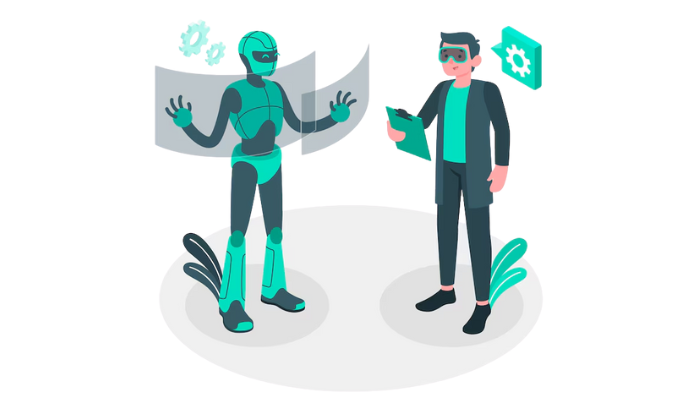AI adoption is expanding fast, but so is the confusion around terminology. If you’re building a product that relies on intelligent automation, chances are you’ve encountered both “AI agents” and “agentic AI” and wondered whether they refer to the same thing.
They don’t.
While both involve autonomous systems that interact with their environment, the scope, complexity, and strategic potential of each are quite different. Misunderstanding the distinction can result in two common pitfalls: overbuilding complex solutions for simple problems, or underbuilding systems that actually require deeper autonomy and adaptability.
A recent survey found that 42 percent of enterprise-scale companies are exploring AI for more than just task automation, aiming instead to develop systems that can reason, learn, and make contextual decisions over time. However, only a small percentage have implemented truly agentic architectures that support goal reprioritization, memory retention, and self-directed action.
If you’re looking for a support assistant that can follow scripted rules, a basic AI agent might be enough. But if your goal is to build an AI system that can plan multi-step workflows, adjust to changing priorities, and operate independently across systems, then you’re looking at agentic AI.
Before you choose your stack or define your product roadmap, it’s critical to understand the technical and operational differences between these two approaches. Let’s start with what AI agents are, and how they work.
What Are AI Agents?
AI agents are software systems designed to perform specific tasks by sensing their environment, processing input, and executing actions based on predefined rules or learned policies. They operate with a clear scope and a fixed goal, often within a controlled context where the range of possible inputs and outputs is predictable.
In simpler terms, an AI agent acts as a digital assistant with a narrow job. It doesn’t change its goal on its own or adapt beyond what it has been programmed or trained to do.
Key Characteristics of AI Agents
- Goal-directed behavior: Agents operate with a clearly defined objective, like answering a customer query, routing a ticket, or identifying anomalies in system logs.
- Reactive logic: Most AI agents respond to inputs based on pre-set instructions or trained models. They don’t initiate goals or adapt strategy without external intervention.
- Limited memory and context: They process current input without retaining long-term context. If memory is used, it’s often for session continuity, not learning or strategic reasoning.
- Predictable performance: They excel in structured environments where rules and outcomes are well defined.
Examples in Real-world Applications
- Chatbots: Customer support agents that handle common queries using rule-based responses or simple natural language processing.
- RPA Bots: Robotic Process Automation tools that mimic human actions to complete back-office tasks like form-filling, invoice processing, or data transfer.
- Navigation agents: AI systems in autonomous vehicles that use real-time sensor data to make local driving decisions within predefined parameters.
Where They Excel
AI agents work best in systems where:
- The task is repetitive and rule-based
- The environment is stable and well understood
- Human oversight is frequent or expected
For example, a logistics company might use AI agents to assign delivery routes based on traffic data. The agent doesn’t plan across weeks or negotiate with vendors, it simply follows a predefined optimization function.
If you’re new to building AI agents, start with our beginner-friendly guide that walks through architecture basics, use cases, and frameworks.
Understanding these limits is important before scaling into more complex, decision-heavy use cases. And that’s where agentic AI comes into play.
What Is Agentic AI?
Agentic AI refers to systems that go beyond narrow, task-based execution. These systems demonstrate the ability to set their own goals, plan multi-step actions, adapt to changing environments, and learn from outcomes over time. Unlike traditional AI agents, agentic AI exhibits behaviors associated with reasoning, autonomy, and intentionality.
In practice, this means an agentic system doesn’t just wait for input and respond. It can take initiative, reprioritize tasks based on context, and even ask follow-up questions or propose alternative solutions to reach a broader objective.
Key Characteristics of Agentic AI
- Proactive autonomy: Agentic AI can independently initiate tasks or shift its behavior in response to new conditions without needing manual input or a rule update.
- Long-term memory and context: These systems retain past interactions, learn from experience, and build models of users, environments, and task histories.
- Dynamic goal setting: Agentic systems can update or generate new goals based on their understanding of a situation or their progress toward existing ones.
- Multi-step planning: They break down complex objectives into sequences of smaller actions, making decisions recursively or hierarchically.
Examples in Real-world Applications
- AutoGPT and BabyAGI: Open-source frameworks that use large language models to perform autonomous research, execute tasks across APIs, and refine their strategies.
- Enterprise copilots: Internal tools that act across systems—like Jira, Slack, Notion, and GitHub—to plan, update, and coordinate team actions without human micromanagement.
- AI product advisors: Systems that can interact with users, review a catalog or dataset, learn preferences, and tailor recommendations based on multi-layered reasoning.
Where Agentic AI Stands Out
These systems are ideal for:
- Complex decision-making where inputs evolve in real time
- Orchestrating multiple tools or APIs in one workflow
- Acting independently across software environments
- Supporting users with ongoing, contextualized assistance
For example, imagine a SaaS platform that uses agentic AI to onboard new customers. Instead of following a static script, the system adapts the onboarding journey based on the user’s behavior, industry, and product configuration—learning over time which paths drive better retention.
Agentic AI is not just more powerful; it’s fundamentally different in how it thinks, acts, and scales. And when compared directly with traditional agents, the contrasts become clear.
AI Agents vs Agentic AI: Head-to-Head Comparison
Choosing between AI agents and agentic AI isn’t just about picking a more advanced system. It’s about matching the right level of autonomy, adaptability, and intelligence to your product’s goals and user expectations.
Here’s how the two approaches compare across core dimensions:
| Feature | AI Agents | Agentic AI |
| Autonomy | Executes predefined tasks within a fixed context | Acts independently across tasks and adapts to new contexts |
| Goal Handling | Follows fixed objectives defined at design time | Can generate, revise, or prioritize goals dynamically |
| Environment | Narrow, structured, and predictable | Open-ended, dynamic, and often multi-modal |
| Planning Capability | Limited or rule-based | Multi-step, recursive, and strategic planning |
| Learning & Memory | Stateless or session-bound | Retains long-term memory and learns from feedback |
| Interaction Style | Waits for user input, reacts accordingly | Can initiate interactions or propose new actions |
| Tool Orchestration | Operates within a single tool or narrow API integration | Coordinates across systems, APIs, and data sources |
| Example Use Cases | Chatbots, RPA bots, basic task assistants | Autonomous research agents, product copilots, strategic advisors |
| Common Tools | Dialogflow, Rasa, LangChain (basic agents) | AutoGPT, ReAct, CrewAI, LangGraph, OpenAI AutoGen |
The choice depends on whether you’re solving for efficiency in a closed loop—or adaptability in a changing environment.
When to Use AI Agents vs Agentic AI
The right choice doesn’t depend on how advanced the system is. It depends on what your product actually needs to do.
If you’re building for speed, scale, and tight control, AI agents will get you there faster. But if your product needs to navigate complexity, adjust in real time, or act across systems without constant hand-holding, agentic AI becomes essential.
Here’s how to decide.
Use AI Agents When:
- The task doesn’t change. You know the input and expected output. Logic is stable, and edge cases are rare.
- Speed matters more than intelligence. You’re optimizing for fast response time, not strategic decision-making.
- You need tight control. Regulatory, compliance-heavy, or highly deterministic systems benefit from AI that stays within guardrails.
- You’re just getting started with automation. Agents are a great way to introduce AI without taking on architectural debt.
Example scenarios:
- Routing inbound tickets to the right department
- Auto-filling insurance claim forms
- Responding to basic FAQs in customer support
In these cases, anything beyond an AI agent would be overkill—and a drag on delivery speed.
Use Agentic AI When:
- Goals can shift mid-process. You’re not just executing instructions. The system needs to decide what to do, not just how to do it.
- You work across tools, teams, or platforms. Agentic AI can orchestrate multi-step flows involving different systems without brittle, rule-based logic.
- Outcomes improve with context. The more the system understands user behavior or past performance, the better its future actions.
- You’re building strategic automation. These aren’t just task bots. They’re long-term operators that evolve with your product and users.
Example scenarios:
- AI that adjusts onboarding flows based on usage and drop-off
- Systems that reprioritize tasks for ops teams based on real-time signals
- Autonomous research agents that investigate, summarize, and propose next steps
How to Choose Based on Constraints
| Decision Factor | AI Agents | Agentic AI |
| Time to deploy | Fast | Longer, requires orchestration |
| System complexity | Low to moderate | High, often spans tools and data layers |
| Cost to operate | Low (rule-based or basic models) | Higher (LLMs, memory, compute) |
| Adaptability needed | Minimal | Essential |
| Team maturity with AI | Entry-level friendly | Requires AI/ML fluency and infrastructure |
| Primary business goal | Automate repetitive work | Improve decisions, optimize outcomes |
In short:
If your system needs to act, start with AI agents.
If your system needs to think, you’re ready for agentic AI.
But adopting agentic systems is not just a product decision, it comes with architectural consequences. Let’s explore what that means in practice.
Architectural Implications for Your Product
The move from AI agents to agentic AI brings significant architectural changes. It affects how your system handles memory, planning, performance, and oversight. Understanding these differences early helps you make scalable decisions without overengineering.
1. System Complexity
Agentic AI systems introduce more components and coordination across layers.
- Memory management
Traditional AI agents work statelessly or use basic session memory. Agentic systems require persistent memory to retain user context, prior actions, and task history. This often involves using a vector database to store and retrieve relevant information based on similarity to current goals. - Planning modules
AI agents execute single, well-defined tasks. Agentic systems need a planning mechanism that can generate sub-tasks, sequence steps, and adjust actions based on changing input. This requires a controller or planner that operates alongside the model, not just inside the prompt. - LLM chaining and orchestration
A single LLM call is no longer enough. Agentic workflows involve multiple LLM prompts, tool calls, and decision points. You will need an orchestration layer to manage these steps reliably and track execution state.
For a deeper look at how agentic systems are architected from memory handling to planning modules, check out our in-depth guide on agentic AI frameworks.
This added complexity enables intelligent behavior but increases the need for strong system design, error handling, and modular architecture.
2. Performance Tradeoffs
Agentic AI systems are more resource-intensive and slower by design.
- Latency
AI agents typically respond in milliseconds. Agentic systems may require several LLM calls, API invocations, and memory lookups before reaching a decision. Response times can range from two to ten seconds depending on depth of planning. - Compute and cost
Each reasoning loop consumes tokens and computes resources. As tasks grow in complexity, your infrastructure must support higher API usage, memory reads, and external tool calls. This affects both your runtime cost and system scalability. - Explainability and debugging
With agents, debugging is straightforward. One input leads to one output. Agentic systems require multi-step tracing. You will need tools or logging frameworks to track each decision, memory retrieval, and tool output to understand the full execution path.
These tradeoffs should be considered upfront, especially in real-time or user-facing products where performance and transparency matter.
3. Human-in-the-Loop Requirements
Greater autonomy increases the need for review, control, and feedback.
- Control checkpoints
Agentic AI may take actions that affect customer experience, system state, or business outcomes. You may need human approval before executing specific actions such as sending emails, modifying records, or deploying updates. - Feedback integration
To improve performance, agentic systems should capture user feedback and route it back into the loop. This can include thumbs up or down, inline corrections, or internal QA scores. Feedback helps refine memory, improve planning, and avoid repeated errors. - Fallback strategies
When the system encounters ambiguity or failure, it must know when to stop, retry, or escalate. Defining fallback conditions and escalation paths is essential to maintain reliability and user trust.
Human oversight is no longer just for edge cases. It becomes a design requirement that supports safe, adaptive automation.
Summary Table
| Area | AI Agents | Agentic AI |
| Architecture | Stateless, rule-based | Modular, stateful with memory and planning |
| Response Time | Fast and predictable | Slower due to multiple steps and memory access |
| Infrastructure Load | Light, minimal coordination | Heavy due to chaining, memory, and orchestration |
| Oversight Role | Optional or manual QA | Required for review, feedback, and escalation |
If your system needs to respond quickly to known inputs, AI agents are sufficient. If your system needs to make context-aware decisions over time, your architecture must support agentic behavior from day one. To see how these systems play out in live environments, let’s walk through practical examples where each approach shines.
Real-World Use Cases
The line between AI agents and agentic AI becomes clearest when applied to actual product scenarios. Below are side-by-side examples across industries and functions, showing where each model fits and what value it delivers.
AI Agents in Action
These systems excel when the scope is fixed, outcomes are predictable, and speed matters more than adaptability.
1. Customer Support Automation
A retail company deploys an AI chatbot to handle order tracking, refund requests, and store hours.
- Uses intent classification and scripted replies
- No memory of past interactions
- Escalates to a human when outside scope
Why it works:
The problem space is narrow, and the value comes from reducing ticket volume, not from dynamic problem-solving.
2. Form Processing in Insurance
An insurer uses an RPA bot integrated with OCR to extract values from claim forms and push them into a CRM.
- Rule-based parsing logic
- Operates on predefined fields
- Fails silently when structure changes
Why it works:
The documents follow templates, and there’s no need to reason across policies or customer history.
3. Task Routing in IT Helpdesk
An internal support system uses keyword matching to tag and assign tickets to the right team.
- No reasoning or learning
- Fast and reliable in high-volume queues
Why it works:
Accuracy depends on trigger words, not context or history.
Agentic AI at Work
These systems are suited for dynamic environments where actions depend on user behavior, evolving data, or system-wide goals.
1. Personalized Onboarding in SaaS
A B2B product uses agentic AI to adjust its onboarding flow based on how users engage during the first week.
- Remembers user actions and skipped steps
- Reorders tutorials and prompts based on observed behavior
- Recommends features aligned with the user’s role
Why it works:
Success depends on long-term engagement, and static flows lead to churn. The system adapts to maximize activation.
2. Revenue Operations in E-commerce
An AI assistant manages discounts, ad spend, and inventory coordination during sales events.
- Evaluates sales patterns and adjusts budget allocations
- Interfaces with marketing, pricing, and logistics tools
- Makes suggestions and triggers automation workflows
Why it works:
The environment changes hourly, and decisions need to span systems and optimize trade-offs across goals.
3. Research Agent in Healthcare
A medical AI agent helps analysts summarize studies and suggest trial candidates.
- Searches databases, parses PDFs, and compares findings
- Maintains task context over multiple queries
- Can be prompted to refine or challenge initial assumptions
Why it works:
Analysts need synthesis, not just search. Agentic AI enables multi-step, evidence-driven decision support.
While the current applications of AI agents and agentic systems already deliver measurable value, the pace of innovation suggests we’re only scratching the surface. To plan strategically, it’s important to understand where these technologies are headed next.
Future Potential of AI Agents and Agentic AI
AI agents and agentic AI are not just solving today’s automation challenges. They are setting the foundation for how digital systems will operate, adapt, and collaborate in the future.
Adoption is growing fast across sectors, and recent research highlights just how significant the shift is becoming.
- Enterprise adoption is accelerating
According to Capgemini’s 2024 AI report, 82 percent of organizations plan to integrate AI agents into their operations within the next one to three years, primarily to improve process efficiency and reduce operational load. - Market growth is substantial
The global AI agents market is projected to grow from 7.63 billion USD in 2025 to 47.1 billion USD by 2030, with a compound annual growth rate of 44.8 percent. - Agentic AI is gaining enterprise traction
Gartner forecasts that by 2028, 33 percent of enterprise software applications will include agentic AI capabilities, compared to less than 1 percent in 2024. This reflects a growing demand for systems that can learn, reason, and adapt across tools. - Organizational design is shifting with AI
Mercer reports that 2025 will be a key inflection point for agentic AI in human resources and business operations, particularly in areas like workforce planning, decision intelligence, and automated advisory systems.
Agentic AI is not a future concept. It is a near-term reality that will shape how products are designed, how teams operate, and how decisions are made at scale. If you’re planning to implement these systems in your product or operations, Codewave can help you build the right foundation from day one.
How Codewave Helps You Build AI Agents and Agentic Systems
At Codewave, we help businesses implement AI systems that are intelligent, adaptive, and aligned with real operational needs. Whether you’re automating a simple task or orchestrating cross-functional workflows, we design AI agents and agentic architectures that fit your environment and scale with your business.
We begin by understanding your goals, systems, and users. Our team then builds custom AI agents that handle repetitive tasks such as ticket routing, form extraction, or user query classification. For businesses that need more advanced capabilities, we develop agentic systems that can plan tasks, reprioritize goals, interact with APIs, and operate across multiple tools with minimal oversight.
What You Get with Codewave
- Context-aware agents integrated into your platforms using secure, scalable APIs
- Goal-driven systems that use memory, planning, and reasoning to manage complex workflows
- Modular architecture that supports future growth and system expansion
- Transparent, observable AI with human-in-the-loop features for sensitive decision points
We use modern agent frameworks like LangChain, ReAct, AutoGen, and LangGraph, depending on your stack. We also support cloud-native deployment across AWS, Azure, and private infrastructure. Not sure which tools are best for your product? See our breakdown of the top agentic AI frameworks and platforms to compare features and use cases.
What It Means for Your Business
- Faster execution with less manual intervention
- Smarter decision-making through adaptive systems
- Higher productivity and better user experiences across teams and touchpoints
Curious how AI could improve your product or operations?
Explore our AI services and portfolio to see how we help businesses bring intelligent automation to life. Book a demo session and get started today!
Codewave is a UX first design thinking & digital transformation services company, designing & engineering innovative mobile apps, cloud, & edge solutions.







